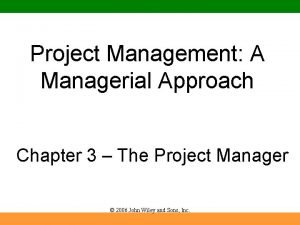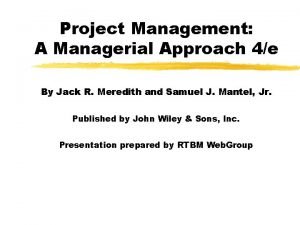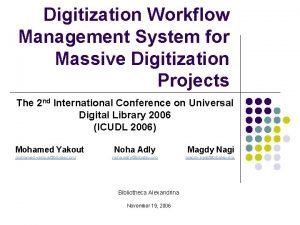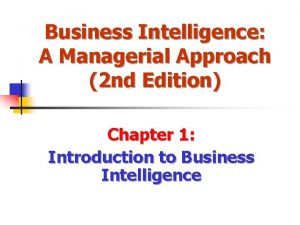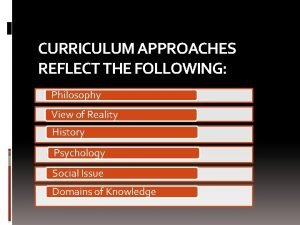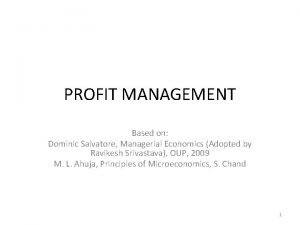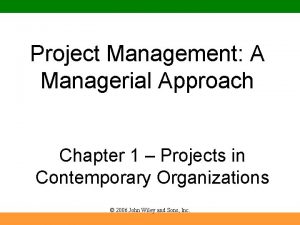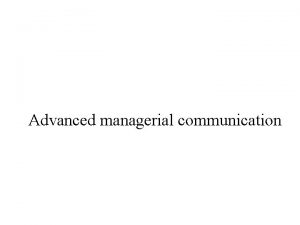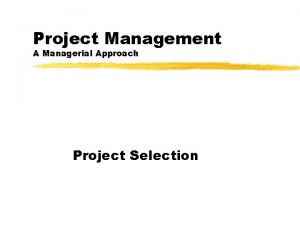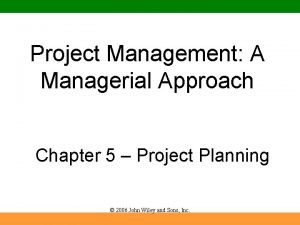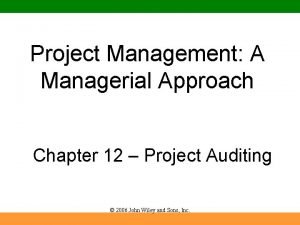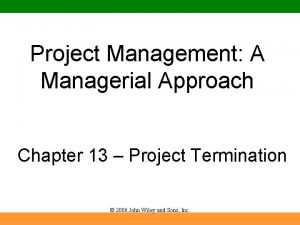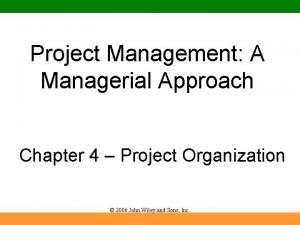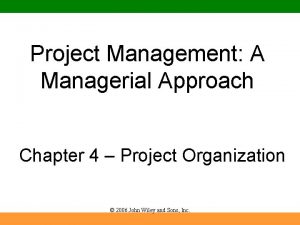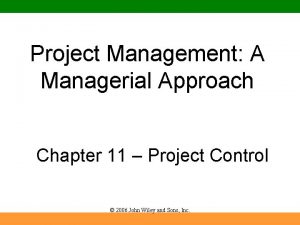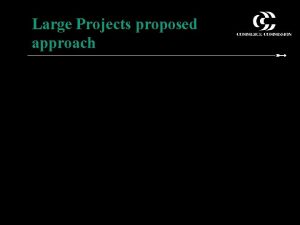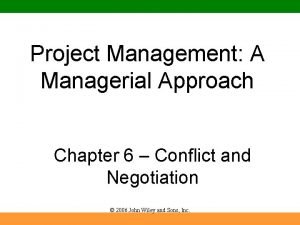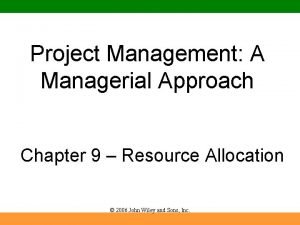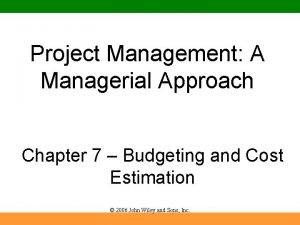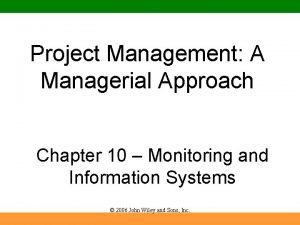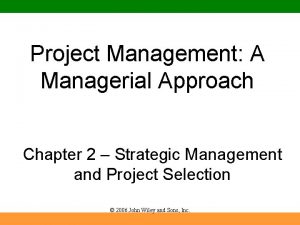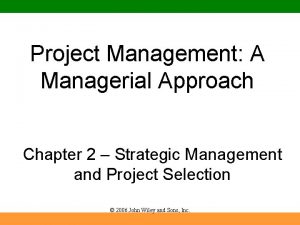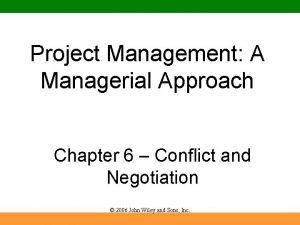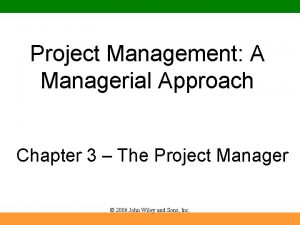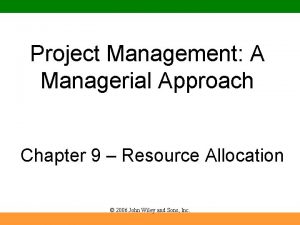Project Management A Managerial Approach Chapter 1 Projects



























- Slides: 27

Project Management: A Managerial Approach Chapter 1 – Projects in Contemporary Organizations © 2006 John Wiley and Sons, Inc.

Overview • • • Project Management Growth Factors Project Aspects Project Criteria Project Life Cycle Project Management Profession © 2006 John Wiley and Sons, Inc.

Project Management Emergence • Explosion in human knowledge • Mass customization of products and services • Expansion of global markets © 2006 John Wiley and Sons, Inc.

Forces Of Project Management • Forces driving Project Management: – 1. exponential expansion of human knowledge – 2. growing demand for a broad range of complex, sophisticated, customized goods and services – 3. evolution of worldwide competitive markets for the production and consumption of goods and services • Team-based problem solving v. individual © 2006 John Wiley and Sons, Inc.

The Professionalism of Project Management Complexity of problems facing the project manager • • Growth in number of project oriented organizations – The Project Management Institute (PMI) was established in 1969 – By 1990 it had 7, 500 members – 1995, over 17, 000 members – 1998 --exploded to over 44, 000 members • This exponential growth is indicative of the rapid growth in the use of projects • Importance of PMI as a force in the development of project management as a profession © 2006 John Wiley and Sons, Inc.

Project Management Institute: Membership Growth Curve © 2006 John Wiley and Sons, Inc.

Organizational Imperatives • • Traditional hierarchical management declining Consensual management increasing Increasing reliance on systems engineering Projects integral to organizational strategy © 2006 John Wiley and Sons, Inc.

The Definition of a “Project” • Must make a distinction between terms: – Program - an exceptionally large, long-range objective that is broken down into a set of projects – Task - set of activities comprising a project – Work Packages - division of tasks – Work Units - division of work packages • A specific, finite task to be accomplished © 2006 John Wiley and Sons, Inc.

Project Management A Working Definition • Project: – A problem with a known solution scheduled for completion—unique and non-routine activities • Project Management: – The science and art of solving the problem within predetermined time and resource parameters – Shouldering just enough risk to escape with your career intact!!! © 2006 John Wiley and Sons, Inc.

Characteristics of a Project • • Have a supported purpose/importance Performance specifications (form, fit, function) Known (bounded) solution Have a life cycle with finite due date Interdependencies Uniqueness Resource requirements and tradeoffs Stakeholder Conflict © 2006 John Wiley and Sons, Inc.

Quasi-Projects and Fuzzy Goals • Tasks without Specific Targets – No Who, What, When, Where, How Much • Implied Performance, Cost, Time Constraints • “Projects” to Determine Project Scope • Warning: If these Become Projects, Expect Delays, Cost Overruns, Dissatisfied Customers © 2006 John Wiley and Sons, Inc.

Objectives of a Project • Project Objectives: – Performance – Time – Cost • Expectations of clients inherent part of the project specifications © 2006 John Wiley and Sons, Inc.

Objectives of a Project • 3 Project Objectives: © 2006 John Wiley and Sons, Inc.

Why Project Management? • Companies have experienced: – Better customer relations – Shorter overall delivery times – Lower costs and higher profit margins – Higher quality and reliability – Higher worker morale © 2006 John Wiley and Sons, Inc.

Why (not) Project Management? • Companies have also experienced some negatives: – Greater organizational complexity – Increased likelihood of organizational policy violations – Higher costs – More management difficulties – Low personnel utilization © 2006 John Wiley and Sons, Inc.

The Project Life Cycle • Stages of a Conventional Project: – Slow beginning – Buildup of size – Peak – Begin a decline – Termination © 2006 John Wiley and Sons, Inc.

The Project Life Cycle © 2006 John Wiley and Sons, Inc.

The Project Life Cycle • Projects also exist which do not follow the conventional project life cycle • Comprised of subunits that have little use as a stand alone unit, yet become useful when put together © 2006 John Wiley and Sons, Inc.

The Project Life Cycle • Time distribution of project effort is characterized by slowrapid-slow © 2006 John Wiley and Sons, Inc.

Project Management Life Cycle Planning Implementation Delivery Level of effort Definition 1. Goals 2. Specifications 3. Scope 4. Responsibilities 5. Teams 1. WBS 2. Budgets 3. Resources 4. Risks 5. Schedule 1. Status reports 2. Change Orders 3. Quality Audits 4. Contingencies © 2006 John Wiley and Sons, Inc. 1. Train user 2. Transfer documents 3. Release resources 4. Reassign staff 5. Lessons learned

Proactive Project Life Cycle High Level of Value of Effort Project Manager Roles and Responsibilities Change Management System Closed-Loop Planning-Monitor-Control System Project Evaluation (Audit) Process Low Define Scope Tradeoffs Plan WBS/OBS/Schedule Detailed Budget Implement Delivery Resource (Re)allocation “Learn Curve” Cost Containment Final Report © 2006 John Wiley and Sons, Inc.

The Project Life Cycle • Unlike the more conventional life cycle, continued inputs of effort at the end of the project produce significant gains in returns © 2006 John Wiley and Sons, Inc.

Projects in Contemporary Organizations Figure 1 -3 © 2006 John Wiley and Sons, Inc.

Projects in Contemporary Organizations Figure 1 -4 © 2006 John Wiley and Sons, Inc.

Projects in Contemporary Organizations Figure 1 -5 © 2006 John Wiley and Sons, Inc.

Projects in Contemporary Organizations Figure 1 -6 © 2006 John Wiley and Sons, Inc.

Copyright 2006 John Wiley & Sons, Inc. All rights reserved. Reproduction or translation of this work beyond that permitted in section 117 of the 1976 United States Copyright Act without express permission of the copyright owner is unlawful. Request for further information should be addressed to the Permissions Department, John Wiley & Sons, Inc. The Publisher assumes no responsibility for errors, omissions, or damages caused by the use of these programs or from the use of the information herein. © 2006 John Wiley and Sons, Inc.
 Project management a managerial approach
Project management a managerial approach Project management a managerial approach
Project management a managerial approach Group managerial approach in classroom management
Group managerial approach in classroom management Project portfolio matrix dimensions
Project portfolio matrix dimensions Project management and workflow for digitization projects
Project management and workflow for digitization projects Traditional project management vs modern project management
Traditional project management vs modern project management Sport law a managerial approach
Sport law a managerial approach Business intelligence a managerial approach
Business intelligence a managerial approach Managerial approach
Managerial approach Managerial approach in curriculum
Managerial approach in curriculum Activity based approach in software project management
Activity based approach in software project management Software project management lectures
Software project management lectures Risk management in telecommunication projects
Risk management in telecommunication projects Cost management in agile projects
Cost management in agile projects The role of project management in achieving project success
The role of project management in achieving project success Walker royce software project management
Walker royce software project management Project cost duration graph
Project cost duration graph Modern project management began with what project
Modern project management began with what project Project evaluation in software project management
Project evaluation in software project management When conducting post project audits
When conducting post project audits Microsoft project agile project management
Microsoft project agile project management Project termination
Project termination Profit management in managerial economics
Profit management in managerial economics Datagram vs virtual circuit
Datagram vs virtual circuit Cognitive approach vs behavioral approach
Cognitive approach vs behavioral approach Waterfall approach marketing example
Waterfall approach marketing example Multiple approach-avoidance conflict
Multiple approach-avoidance conflict Cognitive approach vs behavioral approach
Cognitive approach vs behavioral approach
